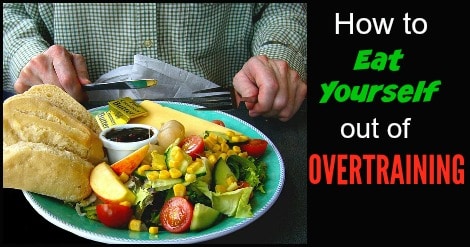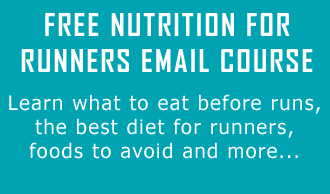If you’re a fairly serious runner, you’re bound to go through periods in your training cycle that you over do it. Even elite runners – who have coaches literally monitoring almost every step they take – fall into the trap of training too hard and pushing their body beyond its limits. After years of studying competitive athletes, I am pretty sure this desire to continuously push the limits is genetically embedded in all runners.
While finding the perfect balance between putting in the necessary miles and allowing for proper recovery is the Holy Grail for all runners, the reality is that runners often over step the tight rope that is optimal training and find themselves desperate to recover and bordering on overtrained.
If you ever find yourself in this dreaded position here are three easy nutrition changes you can make to help dig yourself out of that ovetraining hole.

Increase your caloric intake
The first thing a runner has to look at when they’re overly tired or possibly overtained is the amount of calories they’re taking in on a daily basis. The reality is, most runners do not eat enough calories to fuel their calorie expenditure. This lack of calories means the muscles aren’t getting the nutrients and fuel they need to recover.
Usually, this caloric deficit is a result of runners wanting to lose weight to hit their “racing weight” or to be healthier in general. Unfortunately, trying to lose weight and training hard are two diametrically opposite goals; you need to restrict calories to lose weight and you need to consume calories to train hard.
So, if you find yourself feeling lethargic or riding that line between overtraining and optimal training, it’s important that put your weight loss goals on hiatus for a few weeks and give your body the fuel it needs to recover.
How to intelligently increase calorie intake
The first step is to determine how many calories you’re burning per day. This number includes your basal metabolic rate (how many calories you burn without exercise) plus the number of calories you burned on your run. For a simple way to way to determine this number, you can use this handy runner’s calorie calculator.
RunnersConnect Bonus Extra
Get the only runner’s calorie calculator that factors in your metabolism and the miles you ran to help you determine exactly how many calories you burned each day. Plus, get a breakdown of how many calories you need to eat (including how many carbs, proteins and fats you should target) to lose weight.
Next, since you’re focused on optimal recovery, add an extra 300-500 calories to your total calorie expenditure to guarantee you’re getting the calories and nutrients you need. While it may feel like you’re cheating your weight-loss goals in the short-term, calorie cycling (a short period of eating more calories) can actually help dieters breakthrough weight-loss plateaus by resetting the metabolism (but that’s an article in itself).
It’s also important that you increase your calorie intake at the right times and with the right foods. Simply eating an extra helping at dinner or having a handful of junk food at work isn’t going to help you recover. Instead, focus on adding nutrient-dense and protein-rich foods immediately before or after your workouts or adding a protein supplement to your morning or nighttime routine. By eating the right foods at the right time, you can increase the speed at which your body recovers.
Eat healthy, lean sources of protein
Protein is the main muscle building nutrient required to repair the small micro-tears runners inflict on their muscles with every hard workout they run. Therefore, it is critical that runners who are in danger of overtraining consume ample amounts of lean protein. This extra protein consumption will provide the essential nutrients and amino acids needed for muscle repair.
How to incorporate extra protein in your diet
The most complete proteins come from animal sources such as fish, poultry and limited amounts of red meat. If you think you’re slightly overtrained or you’re riding that fine line, consider adding salmon, tuna and chicken to your everyday menu. These protein sources also have other important nutrients, such as omega-3 fatty acids and iron.
Don’t add artificial animal protein sources like cold cuts or processed meats. Simply add grilled chicken breast to your lunch – on a salad or in a sandwich – and include salmon or an occasional red meat for dinner.
If you’re a vegetarian, you’ll need to combine protein sources to ensure you’re getting the full range of essential amino acids. For example, you can combine grains with legumes or dairy, vegetables with soy or dairy, or legumes with nuts. Whatever your favorite combination, make sure you’re eating extra protein if you believe you may be overtrained.
How much protein
As a general rule, runners need 1.2 to 1.7 grams of protein per kilogram of bodyweight. However, because you want to ensure recovery and you’re trying to consume extra calories, you should aim for 2 grams of protein per kilogram of your bodyweight. For example, a 160lb runner (72.7kg) would plan to consume 144 grams or protein per day.
Nutrient-dense fruits and vegetables
The second important power food you’ll want to eat if you believe you are overtrained are fruits and vegetables. Most fruits and vegetables are superfoods for runners who need to focus on recovery because they are nutrient-dense and contain high quantities of essential vitamin and minerals necessary for muscle repair.
How to easily incorporate nutrient-dense fruits and vegetables in your diet
If you’re feeling sluggish and trying to dig yourself out of that ovetraining hole, focus on adding at least one fruit or vegetable to each meal you eat. This will ensure you consume all the vitamins, minerals, and antioxidants you need to optimally fuel and repair your muscles.
If you’re looking for the most nutrient-dense fruit, vegetable and legume options, here is a list of the top 30 super foods based on the ANDI (Aggregate Nutrient Density Index) scoring system:
1. Collard, mustard, & turnip greens
2. Kale
3. Watercress
4. Bok choy
5. Spinach
6. Brussels sprouts
7. Swiss chard
8. Arugula
9. Radish
10. Cabbage
11. Bean sprouts
12. Red peppers
13. Romaine lettuce
14. Broccoli
15. Carrot juice
16. Tomatoes & tomato products
17. Cauliflower
18. Strawberries
19. Pomegranate juice
20. Blackberries
21. Plums
22. Raspberries
23. Blueberries
24. Papaya
25. Brazil nuts
26. Oranges
27. Tofu
28. Beans (all varieties)
29. Seeds: flaxseed, sunflower, sesame
30. Walnuts
Sample diet for the overtrained runner
Reading general nutritional advice can often be a little confusing, at least it is for me. You’ve now got three very helpful tips to help eat yourself out of being overtrained, but how does it all come together in a daily diet?
To help you out, here is a sample diet for the average runner fighting overtraining. Note, you won’t see serving sizes because each persons caloric needs may be different. However, you can use the calorie calculator for runners and nutrition labels or nutrition tracking websites to tailor this diet specifically for you.
Sample meal for the overtrained runner
Wake-up: Whey protein shake (to stop nighttime catabolic process)
Breakfast 1: Oatmeal with berries (raspberry, blueberry, or blackberries) and wheat germ. Honey for taste.
Breakfast 2: Reduced fat Greek yogurt with fruit
Lunch: Grilled chicken sandwhich and small spinach salad with peppers, broccoli, carrots, tomatoes, tuna, and sunflower seeds. Use a small amount of olive oil or mandarin oranges for dressing if needed.
Midday snack: Oranges or handful of nuts (Brazilian, walnut, pistachio)
Dinner: Salmon with brown rice and asparagus
Nighttime snack: Cottage cheese with strawberries.
Post workout nutrition: Recovery drink or Gatorade and Powerbar.
Feel free to mix and match some of your favorite fruits and vegetables with this generalized diet and make sure to consume an extra 300-500 calories per day. Within a few days you’ll eat yourself right back on track and be feeling fresh, recovered, and ready to train hard.






3 Responses
Great article and timely for me 🙂 I have to really focus on getting in calories or I feel super sluggish. It is hard work eating right and keeping up on the nutrition. I have found that I like drinking Tart Cherry juice as well to boost calorie intake and get in some good antioxidants.
Thanks, Jamie. Love the chart cherry juice idea, good point.
For those of you who have trouble eating enough because you’re not hungry, Jamie also suffers from this issue and we discussed adding liquid calories to her diet. Here’s the shake I eat when I am not feeling hungry but know I need more calories:
2 cups strawberries
1 cup mango
1 banana
1 cup greek yogurt
2 cups V8 fusion
1 cup granola
1/2 cup wheat germ
1 packet carnation instant breakfast
3/4 cup protein powder/whey protein
1 cup water (to make it more viscous)